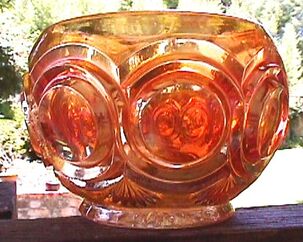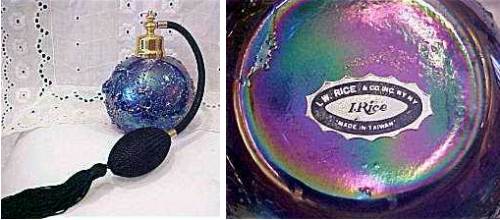Carnival Glass - made in Japan and China / Taiwan!
Japan
Google search around the online world for Japanese glass and the chances are you'll find yourself wading through glass fishing floats and glass beads (some of which are fabulously iridised), but you may also just come across some Carnival Glass ..... read on.
The development of the glass industry in Japan is fairly recent, compared to many other countries. Although it has its roots in the 1800s, the industry grew in response to a combination of outside influences and domestic needs. Larger scale production began in the early 1900s, with the demand for lighting and utilitarian tableware, and output was diversified during the 1950s and 1960s when US military personnel in the area started a growing demand for souvenir items. Today it boasts highly sophisticated industrial glass production at one extreme and a thriving studio glass community at the other, and somewhere in between lies the production of tableware and giftware.
Here are some fascinating glass items in marigold Carnival. Each has the distinction of bearing the moulded words MADE IN JAPAN. Photos are courtesy of and Copyright of Tony Hodgson and may not be copied without permission.
The covered sugar on the left was found in Australia some years ago and is in marigold Carnival. It was reported by Yvonne and Jack Dennis and the illustration is based on their line drawing of the item. It is very similar to pattern glass from the United States Glass Company - in fact it has a resemblance to the US Glass design "Bullseye and Fan". But there are differences; the main one is that moulded on the inside of the base are the words: DESIGN PAT. No. 25949 and MADE IN JAPAN. Yvonne and Jack report that the "glass is crude and heavy with bubbles. The marigold iridescence is pale though even on the outside, but rather splotchy on the inside.
On the right (above) is a marigold bowl (perhaps a rose bowl or an open sugar) that was found by Tony Hodgson in New Zealand. Like the one on its left, it also has a United States Glass "feel" to the pattern - a little like "Manhattan" or "The States" and yet not. The bowl also has the words MADE IN JAPAN moulded on the inside of the base.
On the right (above) is a marigold bowl (perhaps a rose bowl or an open sugar) that was found by Tony Hodgson in New Zealand. Like the one on its left, it also has a United States Glass "feel" to the pattern - a little like "Manhattan" or "The States" and yet not. The bowl also has the words MADE IN JAPAN moulded on the inside of the base.
|
Courtesy of Ray Rogers we show on the right this interesting lidded piece. It is also similar to the Bullseye and Fan pattern from United States Glass (and is rather like the line drawing of the Dennis’s piece, above on the left) – but again there are differences. Ray tells us that it stands 7 inches / 18cm from the tip of the finial to the base. It was found in Shanghai. Several more examples of the lower section, shaped more like a rose bowl, have also been found in Australia and New Zealand, and we learned from Mark Strangwidge that the pattern has been called “Far Eastern”. Research into this fascinating item continues. |
Below are more Carnival items that appear to be from Japan:
Above: two items each bearing the same paper label featuring a dog's head as a Registered Trade Mark for "T Yanagawa Glass Works" with "Made in Japan". Both items are marigold and are of relatively thin glass.
Below: left - an ashtray that appears to have Japanese characters moulded on the side; middle - a red Carnival plate that had a paper label on it that
reads "Lefton TRADE MARK EXCLUSIVES JAPAN"; right - two tumblers with a grape pattern, which are moulded "JAPAN" on the base.
Below: left - an ashtray that appears to have Japanese characters moulded on the side; middle - a red Carnival plate that had a paper label on it that
reads "Lefton TRADE MARK EXCLUSIVES JAPAN"; right - two tumblers with a grape pattern, which are moulded "JAPAN" on the base.
The red Carnival plate (above, middle) seems to be Indiana Glass "Heirloom" Series in Sunset Carnival, which is a bit of a conundrum. What we do know, though, is that Lefton is an international importer / wholesaling group based in the USA that sources a great deal of their wares from Japan, including glass. We believe that this style of label was used between 1960 and 1983. Examples, usually vases, also crop up with paper stickers that read: "Lefton's Japan Hand Blown Glass Works".
|
We have also discovered a Contemporary Carnival Glass maker in Japan - the Kamei Glass Company of Osaka, Japan. The company produced a range of glass including tableware, novelties, vases and “Art Glass” from their inception in the 1960s through to their closure in the mid 1990s. The first reported pattern from Kamei Glass is Kamei Peacock Tail had a "CRAFT Happy Happening" label, and is covered on our unique Collectors Facts: Kamei Peacock Tail
China and Taiwan Carnival Glass perfume bottles that made in Taiwan have been known about for some time, and Carnival production in China is confirmed via moulded trademarks and other wording on the glass. There are also other items carry markings that suggest Chinese output, but little detailed information has been forthcoming so far. Modern production of Carnival Glass in China has been reported from at least as early as 2007. Koala and Platypus patterns have been made in the style of old Australian designs; the word “summerland.1” is moulded on the base. The exterior of the bowls features a reproduction of the Classic Australian Fern & Wattle design. Large crimped bowls in blue, purple and white are known and we understand that 500 of each were produced (making 3000 items in total). Picture right of detail on Koala bowl, courtesy of Lee Delany
|
|
Most recently - in January 2022 - we became aware of extensive production of iridised glass in China, described as "lustreware" and "lustre embossed". Thanks to Caroline Griffiths for posting these two pictures (right) in our NetworK Group on Facebook. It is not surprising that Carnival Glass is being made in China - the glassmaking skills are undoubtedly present in that country, and indeed Fenton Art Glass had glass made in China and marketed it under the "Fenton International" label. Pictures, right courtesy of Caroline Griffiths |














